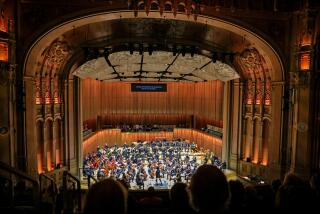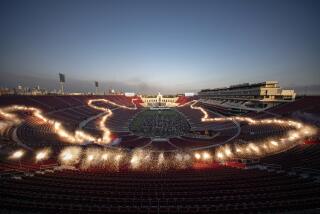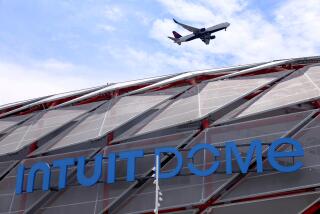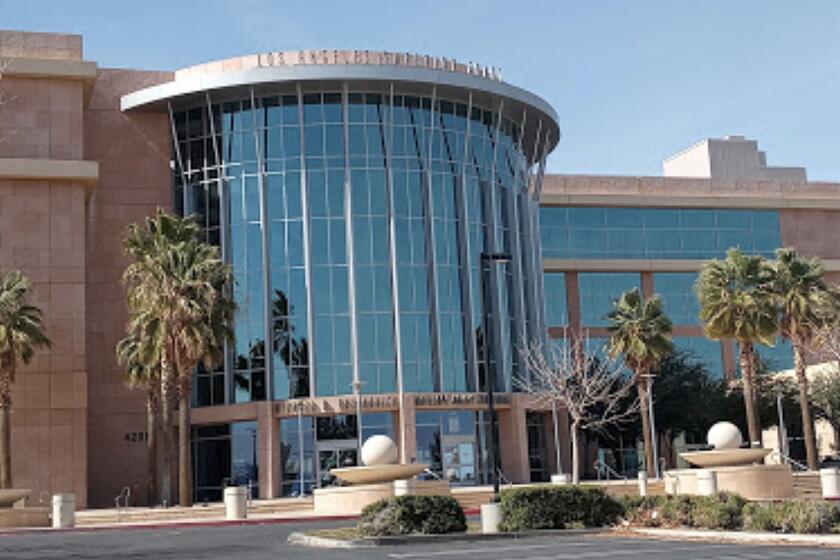Concert Bowl Told to Study Cuts in Noise : Pacific Amphitheatre Must Weigh Methods Presented in Court
- Share via
In a move to settle a 4-year-old lawsuit, Orange County Superior Court Judge Richard J. Beacom Friday ordered owners of the Pacific Amphitheatre in Costa Mesa to study ways to reduce noise levels during concerts.
Ned West Inc.--the firm that operates the open-air concert bowl on a 40-year lease with the state--must consider several proposals that have been presented during the six-week trial, including building a dome-like cover, erecting a sound wall that would reflect the noise back into the bowl or requiring performers to lower the sound volume during concerts.
Citizens Group Prefers Dome
Concerned Citizens of Costa Mesa, the neighborhood group that brought the suit against Ned West, claiming that the amphitheater is a public nuisance, prefers the dome. But the owners have said they would have difficulty raising an estimated $8 million for construction. A 100-foot wall, by contrast, would cost $150,000 to $200,000.
The judge suspended the trial for a week to give the owners time to look at financial options. He ordered all parties to return to court on July 18 to continue settlement talks.
Beacom noted that it is unusual for a judge to get involved in settlements once the trial has begun. But he said he has not decided how he will rule on the nuisance issue if the trial is forced to continue.
Informal Court Session
“I am satisfied from discussions with all parties that everybody here really wants the problem solved and that everybody is in good faith and they want it done right,” Beacom told a small group of residents who gathered in the courtroom for the informal session.
“In the interim, everybody will put their heads to the financing problem and see if they can find some money or some feasible way to raise the money. If they can’t, we’ll have to do it the hard way. We will eventually go back to trial and litigate until the thing is over,” he said. “I’m hoping we will find some daylight on the funding and give us something that is reasonable to pursue.”
Beacom also included a stipulation in the order giving him the right to visit the amphitheater or the neighborhood without notice to either party and to personally monitor the noise levels during concerts.
Attorneys for Ned West refused comment Friday. But attorney Richard L. Spix, who represents Concerned Citizens, said he is optimistic that a settlement can be reached.
“I’m encouraged to think we are closer than we’ve ever been. It’s the first time we’ve heard them talk about a dome,” Spix said.
Charlotte Cleary, president of the Orange County Fair Board--a state entity that oversees the fairgrounds and owns the land where the amphitheater is located--said the board is open-minded to the options. But she added that enclosing the amphitheater would change its character.
“We’re heading toward some sort of solution to the problem, and that has been our intent all along. We want the problem solved, plain and simple,” she said.
“(The dome) would change the whole feeling of the amphitheater, it would no longer be an amphitheater. I don’t know how the board would feel about that.”
The judge presented his proposal to the fair board during a private meeting Thursday. Friday morning he met for two hours with attorneys in his chambers before making his announcement in the courtroom.
Beacom indicated that an agreement could be reached by Sept. 1. But he told residents that it is unlikely the solution can be put in effect by the end of this year.
“Unfortunately, I think you will have to live with this situation the way it is for the balance of the (concert) season,” he said. “And even if it goes through litigation, hopefully this will be the last season.”
Concerned Citizens sued Ned West in 1984, alleging that the 18,500-seat bowl did not comply with state environmental laws and that concert volumes made the facility a neighborhood nuisance. Ned West built the amphitheater in 1983 at a cost of $11 million.
In an effort to find another alternative, the State Fair Board is considering a proposal to buy out the 40-year lease with Ned West. Under the proposal, the state would seek an agreement with Ned West on the value remaining on the lease and the amphitheater itself.
If the two parties cannot agree on price, the state would have authority to condemn the property and pay Ned West the appraised value for the facility. The board would then lease the bowl to another concert promoter.
THE AMPHITHEATER’S YEARS OF SOUND AND FURY
September, 1983: Moved by noise complaints from area residents, the Costa Mesa City Council hires a firm to monitor noise levels.
January, 1984: Concerned Citizens of Costa Mesa, a residents’ group, files a lawsuit against the Orange County Fair Board, seeking a reduction in the size of the Pacific Amphitheatre and its activities.
May, 1984: City officials file three noise complaints against the amphitheater, alleging that an April 28 concert by the Scorpions violated the city’s noise ordinance.
June, 1984: Judge throws out misdemeanor complaints over the Scorpions’ concert, citing as improper the city’s attempt to prosecute under the county, rather than city, anti-noise ordinance. Later, a civil suit brought by citizens seeking to control noise levels at concerts is thrown out by another judge, who says that the complaint was too vague.
July, 1984: The city of Costa Mesa files criminal charges against Ned West Inc., leaseholder and operator of the amphitheater, for exceeding noise limits during a June 30 Jefferson Starship concert.
August, 1984: More charges are filed by the city against Ned West and its executives, this time over a July 21 concert by Rod Stewart. Ned West Inc., in turn, files suit to prevent the city from filing misdemeanor charges against the company.
September, 1984: A $1-million lawsuit is filed against amphitheater owners and operators by seven neighbors of the 18,500-seat bowl. Later, a judge rules that amphitheater officials must obey the city’s noise ordinance.
December, 1984: The City Council votes unanimously to file criminal charges against any band that sustains a decibel level of 50 or more for more than 30 seconds in a one-hour period. Charges are later filed against Jefferson Starship, Black Uhuru, the Pretenders, Rod Stewart and Sheena Easton.
January, 1985: A temporary restraining order is issued that prevents the city from arresting or citing amphitheater performers or operators.
July, 1985: A bill sponsored by state Sen. John Seymour (R-Anaheim) concerning policing of the concerts is approved by a Senate committee.
September, 1985: That bill is shelved in order to allow the Orange County Fair Board’s action against theater operators to proceed.
November, 1985: The residents’ civil suit, overturned in June, 1984, is reinstated by an appellate court.
December, 1986: The state Supreme Court rules that a group of homeowners may proceed with their lawsuit against operators of the bowl.
May, 1987: A judge orders the amphitheater to lower noise levels.
June, 1987: A judge orders theater operators to lower the sound after two concerts, by the Kinks and Tom Petty and the Heartbreakers, exceed limits set by the court. The management, claiming that sound reduction could hurt their business, delays action, prompting neighboring homeowners to seek a contempt charge.
July, 1987: A judge orders theater operators to warn all performers that they may be held liable if their shows exceed noise limits. A court order limiting concert volume is later blocked by a state appellate judge.
August, 1987: The July order is lifted by another appellate judge.
April, 1988: The neighborhood anti-noise group is granted a May 9 trial date in its suit against the amphitheater. Later, the Costa Mesa City Council approves a proposed settlement with the Orange County Fair Board and Ned West. Under the settlement, operators would pay penalties of up to $9,000 per day, which would be used by neighboring homeowners for soundproofing purposes. Settlement is opposed by homeowners unless certain changes are made.
June, 1988: Saying that homeowners waited too long before filing, a judge throws out part of the residents’ lawsuit alleging that state environmental laws were violated when the amphitheater was built. Their complaint claiming the theater is a public nuisance was allowed to stand.
More to Read
Sign up for Essential California
The most important California stories and recommendations in your inbox every morning.
You may occasionally receive promotional content from the Los Angeles Times.










